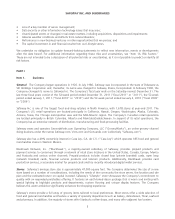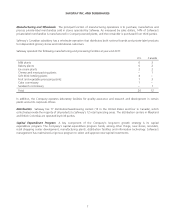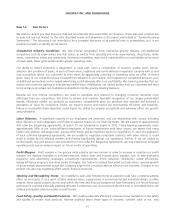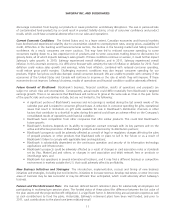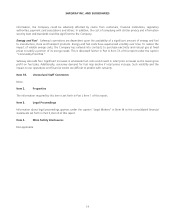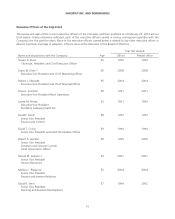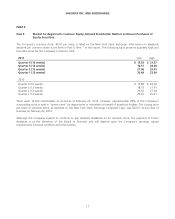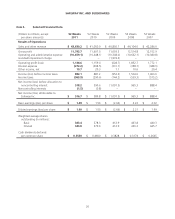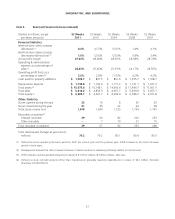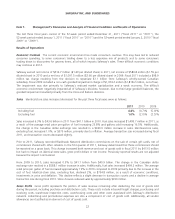Safeway 2011 Annual Report Download - page 31
Download and view the complete annual report
Please find page 31 of the 2011 Safeway annual report below. You can navigate through the pages in the report by either clicking on the pages listed below, or by using the keyword search tool below to find specific information within the annual report.SAFEWAY INC. AND SUBSIDIARIES
Legal Proceedings From time to time, we are a party to legal proceedings, including matters involving personnel and
employment issues, personal injury, antitrust claims, intellectual property claims and other proceedings arising in the
ordinary course of business. In addition, there is an increasing number of cases being filed against companies generally,
which contain class-action allegations under federal and state wage and hour laws. We estimate our exposure to these
legal proceedings and establish reserves for the estimated liabilities. Assessing and predicting the outcome of these
matters involves substantial uncertainties. Although not currently anticipated by management, unexpected outcomes in
these legal proceedings, or changes in management’s evaluations or predictions, could have a material adverse impact on
our financial results.
Insurance Plan Claims We use a combination of insurance and self-insurance to provide for potential liabilities for
workers’ compensation, automobile and general liability, property risk (including earthquake coverage), director and
officers’ liability, employment practices liability, cyber risks, terrorism and employee health care benefits. We estimate the
liabilities associated with the risks retained by us, in part, by considering historical claims experience, demographic and
severity factors and other actuarial assumptions which, by their nature, are subject to a high degree of variability. Among
the causes of this variability are unpredictable external factors affecting future inflation rates, discount rates, litigation
trends, legal interpretations, benefit level changes and claim settlement patterns.
The majority of the Company’s workers’ compensation liability is from claims occurring in California. California workers’
compensation has received intense scrutiny from the state’s politicians, insurers, employers and providers, as well as the
public in general. Recent years have seen escalation in the number of legislative reforms, judicial rulings and social
phenomena affecting our business. Some of the many sources of uncertainty in the Company’s reserve estimates include
changes in benefit levels, medical fee schedules, medical utilization guidelines and apportionment. Reversals of reforms by
legislation or judicial action could have a material adverse impact on our financial results.
Leadership Development and Succession Planning The training and development of our future leaders is important
to our long-term growth. We rely on the experience of our senior management, who have specific knowledge of our
business and industry that is difficult to replace. If we are unable to attract and retain highly-qualified senior management
or effectively provide for the succession of senior management, including our Chief Executive Officer, our business may
be adversely affected.
Impairment of Long-Lived Assets Our long-lived assets, primarily stores, are subject to periodic testing for
impairment. Failure to achieve sufficient levels of cash flow at reporting units could result in impairment charges on long-
lived assets. We have incurred significant impairment charges to earnings in the past, including fiscal 2011, 2010 and
2009.
Information Technology Risks The Company has large, complex information technology systems that are important
to business operations. If we were to experience difficulties maintaining, expanding or upgrading existing systems or
implementing new systems, we could incur significant losses due to disruptions in our systems.
Additionally, Safeway gathers and retains personal information that customers provide to us. The Company also receives
and stores personal information in connection with our human resources organization. Despite the Company’s
considerable efforts to secure our computer network, security could be compromised, confidential information could be
misappropriated or system disruptions could occur. This could cause significant damage to our reputation, affect our
relationships with our customers and employees and lead to claims against the Company.
As a merchant who accepts debit and credit cards for payment, Safeway is subject to the Payment Card Industry Data
Security Standard (“PCI DSS”), issued by the PCI Council. PCI DSS contains compliance guidelines and standards with
regards to the Company’s security surrounding the physical and electronic storage, processing and transmission of
individual cardholder data. By accepting debit cards for payment, Safeway is also subject to compliance with American
National Standards Institute encryption standards, and payment network security operating guidelines. Despite Safeway’s
compliance with these standards and other security measures, we cannot be certain that all of our IT systems are entirely
free from attack or security breach. To the extent that any disruption results in a loss, damage or misappropriation of
13




